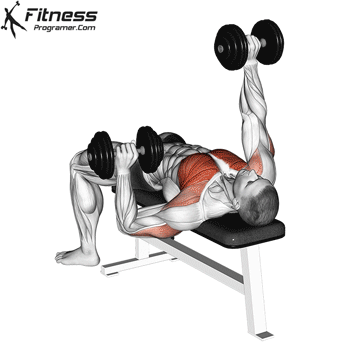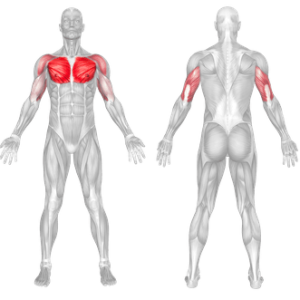Alternate Dumbbell Bench Press Overview
The Alternate Dumbbell Bench Press is a chest exercise performed on a flat bench, where you press one dumbbell at a time while holding the other dumbbell at the top position. By alternating the pressing motion, this exercise introduces an extra challenge to your coordination and balance, helping to address muscle imbalances while targeting the chest.
How to Perform:

Setup:
- Choose Appropriate Dumbbells
- Select dumbbells that allow you to maintain proper form throughout the exercise.
- Set Up the Bench
- Lie flat on a sturdy bench with your feet planted firmly on the ground.
- Position Yourself
- Hold a dumbbell in each hand with your arms extended directly above your shoulders, palms facing forward.
Execution:
- Starting Position
- Lower one dumbbell slowly to the side of your chest while keeping the other arm extended above your shoulder.
- Press the Dumbbell Up
- Exhale as you press the dumbbell back to the starting position.
- Switch Arms
- Lower the opposite dumbbell while keeping the first arm extended at the top.
- Alternate Repetitions
- Continue alternating arms for the desired number of repetitions, maintaining control throughout the movement.
- Completion
- Once you finish your set, carefully lower both dumbbells to your chest and sit up with control.
Tips for Proper Form
- Engage Your Core: Keep your core tight to prevent your torso from rotating during the alternating motion.
- Control the Movement: Avoid rushing; lower and press the dumbbells in a slow, controlled manner.
- Maintain Alignment: Your wrists should stay aligned with your forearms, and your elbows should stay at a 45-degree angle to your torso.
- Full Range of Motion: Lower the dumbbell until it’s level with your chest to ensure a complete range of motion.
- Stable Base: Keep your feet firmly planted on the floor to provide a stable base for the lift.
Common Mistakes to Avoid
- Uneven Range of Motion
- Ensure both arms follow the same range of motion to prevent muscle imbalances.
- Rushed Reps
- Perform each rep slowly and deliberately to maximize muscle engagement.
- Arching the Lower Back
- Keep your back flat on the bench by engaging your core and glutes.
- Elbow Flaring
- Avoid letting your elbows flare out too far, as this can strain your shoulders.
- Using Excessive Weight
- Start with lighter dumbbells to master proper form before increasing the weight.
Benefits of the Alternate Dumbbell Bench Press
- Improves Muscle Imbalances
- By working one arm at a time, this exercise helps correct strength and size differences between your dominant and non-dominant sides.
- Enhances Core Stability
- The alternating motion challenges your core to stabilize your torso throughout the exercise.
- Increases Range of Motion
- Dumbbells allow for a deeper stretch compared to a barbell, promoting better muscle activation.
- Builds Functional Strength
- The unilateral nature of the movement mimics real-life activities and improves overall stability and coordination.
- Protects Joints
- Dumbbells allow for a natural range of motion, reducing strain on the shoulders and wrists.
How to Integrate Exercise into Your Routine
The Alternate Dumbbell Bench Press can be used as a primary chest exercise or as an accessory movement:
- Push Day Routine: Combine it with exercises like overhead presses and triceps dips.
- Chest-Focused Workout: Pair it with incline presses, cable flyes, and push-ups for a complete chest session.
- Functional Strength Training: Include it in a circuit with pull-ups, rows, and core exercises.
Alternate Dumbbell Bench Press Muscles Worked

